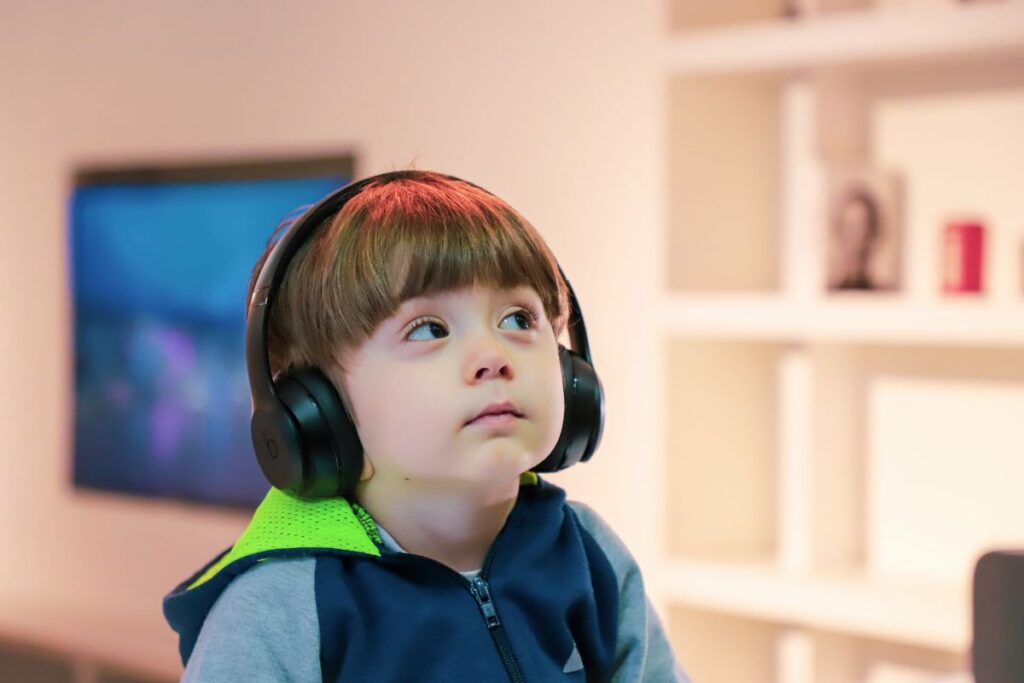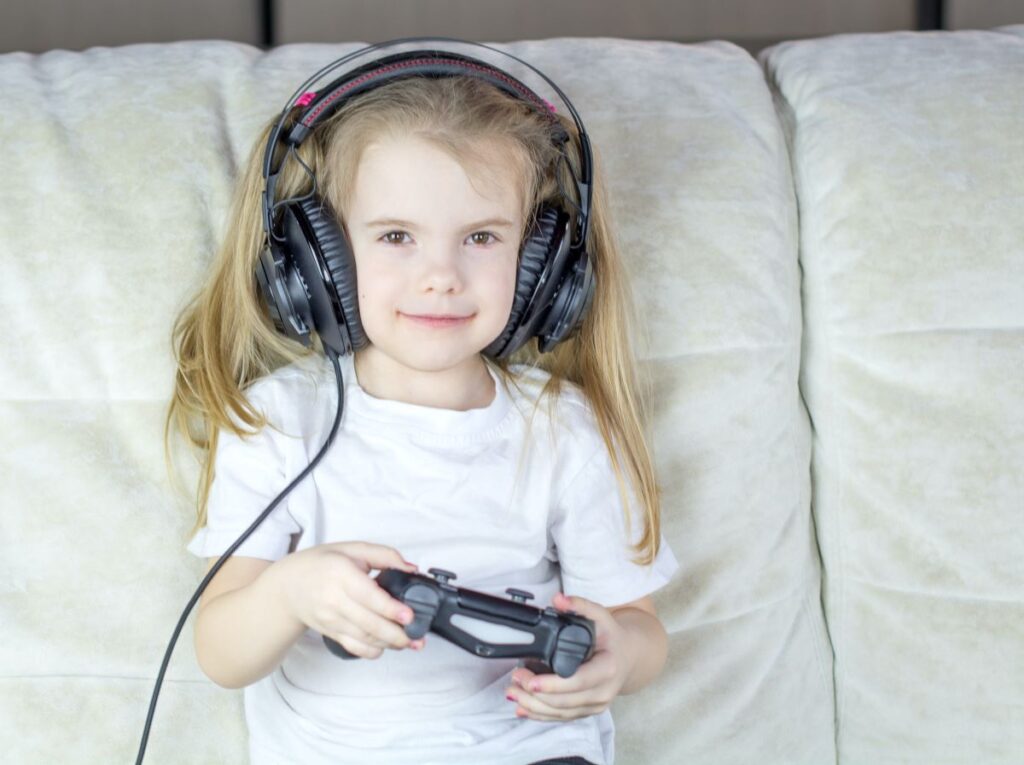
Autism spectrum disorders are characterised by difficulties in developing social, cognitive or physical skills from childhood, although presentation of autism is very heterogeneous (Frye et al, 2018). Repetitive behaviours, difficulty engaging in activities and in communication are common, meaning children with autism require a lot of support growing up (Brian et al, 2012). Families play an important role but so do medical professionals and therapists, who work closely with children as part of a long-term therapy plan. Evidence shows that children with autism significantly benefit from early interventions for language and communication development, as well as reinforcing that there is no one way to achieve good outcomes (Jiménez-Muñoz et al, 2021).
Most children in modern households have access to technological devices, like smartphones, computers, tablets, gaming sets, even virtual reality kits (Valentine et al, 2020).
In a recent systematic review, video games have been shown to help children with attention deficit hyperactivity disorder (ADHD) improve their cognitive skills and have been well accepted by young people (Peñuelas-Calvo et al, 2020). Another review focusing on neurodevelopmental disorders in 2020, also demonstrated some effectiveness of technology-based interventions for skills rehabilitation (Althea et al, 2020).
The review that’s the focus of this blog, by Jiménez-Muñoz et al. (2021), discusses the current evidence for effectiveness and feasibility of game based interventions in the treatment of autism in children. So, how can we use games in autism to the children’s advantage, combining the building of important skills with a bit of fun?

Children with autism benefit from early interventions for language and communication development, but there’s no single way to help everyone.
Methods
Researchers retrieved studies from four databases and two reviewers worked independently to assess the study eligibility based on the inclusion criteria set in advance. Studies that did not include children in their sample were excluded, as well as those with no measurable outcomes. The range of outcomes for inclusion was wide and included that studies needed to have a sample size of more than five participants and use any video-game based method as their intervention.
Effectiveness was assessed in relation to the relevant outcomes for each study, ranging from subjective symptom reduction to academic performance or adherence to other aspects of therapy, like medications. Percentage improvement scores were extracted from studies when available, or calculated for the purpose of this review analysis to compare pre- and post- game effect.
Feasibility of interventions, which was the review’s secondary outcome, was measured by response rates and acceptability.
The review does not contain a meta-analysis pooling together the findings of multiple studies. Instead, the papers are grouped by subject and assessed in those groups.
Results
Most studies tended to agree and offer supportive evidence for video game use in autistic children. Different types of games promoted different skillsets; for example, exergames (games involving exercise) helped children work on motor function, while other online games built on memory and processing skills or even social and teamwork skills based on the game design and goal.
A total of 24 studies were reviewed, 11 of which focused on cognitive training, while other common types were physical, social and neurofeedback training.
- Two of the papers on cognitive training found no significant improvement, while the other 9 showed an increase in reading or mathematic skills, academic performance, concentration or reaction time.
- Two studies focused on emotion recognition training with good outcomes and one study aimed to decrease auditory hypersensitivity via video game play with positive results.
- Exergames were found to improve motor skills in all six studies reviewed.
- With regards to social training, 3 of the 5 papers described statistically significant improvement in aspects of social interaction after asking children to take part in games where they had to collaborate.
- An improvement in attention skills was observed in children taking part in one of the studies using neurofeedback training, where the game triggered different actions based on children’s attention levels. The other study in this group showed decreased levels of parental anxiety with the intervention, but no significant change in children’s anxiety.
For all studies, low drop-out rates were observed, with the majority reporting 100% completion rate. Reasons for disengagement from the studies were related to lack of interest or practical issues with session attendance.

Two of the studies on cognitive training found no significant improvement, while the other 9 showed an increase in reading or mathematic skills, academic performance, concentration or reaction time.
Conclusions
Overall, this review suggests that video games may have potential for skills development in autism management, if they are integrated appropriately as part of a wider therapeutic plan. Both parents and children appear to welcome this new type of intervention. While more studies are needed with longer follow up and larger sample sizes, timely adaptation of game design to facilitate promotion of certain skills can mean that video game therapy becomes a part of the weekly routine of young people with autism spectrum disorders.

Video games may have potential for skills development in autism management, if they are integrated appropriately as part of a wider therapeutic plan.
Strengths and limitations
This review provides a very comprehensive summary of the recent articles studying the effect of video game based interventions in the treatment of autism spectrum disorder in children. It provides evidence that are consistent with previous research and has the advantage of including many types of game-play compared to previous reviews. However, this meant that studies varied significantly in their methods, but also in their measurable outcomes, which is a common limitation of large systematic reviews. This review helps group studies together to compare the impact of similar interventions independently, as the authors acknowledge it is difficult to pool effects that focus on different aspects of skill rehabilitation; for example, emotion recognition training, social interaction, processing speed, memory etc. Considering the variability in outcomes and the small sample sizes in most of the studies, it can be difficult to generalise these results.
More research studies are needed on different types of video-game based interventions. This will also help address specific symptoms more appropriately for each child or adolescent by choosing games that target the skillset most relevant to their issues and development goals. This is particularly relevant in autism spectrum disorder patients, who can differ significantly in the way that features of autism are manifested.
In future research, using standardised methods to measure the impact of these interventions would also be helpful in later comparing the results from different studies. Standardised outcomes will also facilitate future integration in clinical practice. Another limitation of the studies present in literature is the limited follow up time post-intervention, with a range of 2-23 weeks, and therefore future studies should aim to include longer follow up times.

In future research, using standardised methods to measure the impact of video-game based interventions would also be helpful in later comparing results from different studies.
Implications for practice
The accessibility of these interventions and the high levels of adherence as shown in studies so far, renders video games a popular, flexible platform for delivering aspects of neurodevelopmental therapy in the community. Parental attitudes towards the role of video game based interventions can be an important determinant when trying to implement this in practice as most of these interventions can be part of home-based activities and might require some parental encouragement but also supervision. Parents would likely have to play an active role in encouraging young people to transfer the social, emotional or cognitive skills they would slowly acquire to the real-life world to avoid isolation or video game dependence.
As mentioned by Jiménez-Muñoz et al, it is important to also note the concerns about gaming addiction, when suggesting this as a long-term intervention. In practice, it would be important to set up follow-up assessments to monitor progress of therapy and screen for risks associated with excessive video game use.
Finally, acknowledging the fast pace at which the gaming industry produces new game designs and software, the need for up-to-date gaming development for autism spectrum disorders should be stressed. Considering that research work so far is based on games specifically designed for autism, we need to explore how easy it can be to adapt commercial games to the needs of this population to make this a more realistic project for practice.
Interestingly, video-game based assessments could potentially be used in the diagnosis of neurodevelopmental disorders like autism. Promising results are available by Anzulewicz et al. in 2016, when they discuss how motor patterns in game play can help demonstrate autism. This could mean that video games could be integrated in more than one aspect of autism care with the potential of creating computational markers for both the diagnosis and monitoring of video game effects during development at different ages.

Wide accessibility of games and high adherence rates from young people render video games a popular platform for improving cognitive, social or physical skills in autism.
Statement of interests
No conflicts of interest.
Links
Primary paper
Jiménez-Muñoz L, Peñuelas-Calvo I, Calvo-Rivera P, Díaz-Oliván I, Moreno M, Baca-García E, Porras-Segovia A. (2021) Video Games for the Treatment of Autism Spectrum Disorder: A Systematic Review. J Autism Dev Disord. 2021 Mar 2.
Other references
Althea Z. Valentine, Beverley J. Brown, Madeleine J. Groom, Emma Young, Chris Hollis, Charlotte L. Hall, A systematic review evaluating the implementation of technologies to assess, monitor and treat neurodevelopmental disorders: A map of the current evidence, Clinical Psychology Review, Volume 80, 2020
Anzulewicz, A., Sobota, K. & Delafield-Butt, J. Toward the Autism Motor Signature: Gesture patterns during smart tablet gameplay identify children with autism. Sci Rep 6, 31107 (2016).
Brian A. Boyd, Stephen G. McDonough, James W. Bodfish, Evidence-Based Behavioral Interventions for Repetitive Behaviors in Autism, J Autism Dev Disord. 2012 Jun; 42(6): 1236–1248.
Finke EH, Hickerson B, McLaughlin E. Parental intention to support video game play by children with autism spectrum disorder: an application of the theory of planned behavior. Lang Speech Hear Serv Sch. 2015 Apr;46(2):154-65.
Frye, R.E. Social Skills Deficits in Autism Spectrum Disorder: Potential Biological Origins and Progress in Developing Therapeutic Agents. CNS Drugs 32, 713–734 (2018).
Mura, G., Carta, M. G., Sancassiani, F., Machado, S., & Prosperini, L. (2018). Active exergames to improve cognitive functioning in neurological disabilities: A systematic review and meta-analysis. European journal of physical and rehabilitation medicine, 54(3), 450–462.
Peñuelas-Calvo I, Jiang-Lin LK, Girela-Serrano B, Delgado-Gomez D, Navarro-Jimenez R, Baca-Garcia E, Porras-Segovia A. Video games for the assessment and treatment of attention-deficit/hyperactivity disorder: a systematic review. Eur Child Adolesc Psychiatry. 2020 May 18.
Rhea P. Interventions to improve communication. Child Adolesc Psychiatr Clin N Am. 2008 Oct; 17(4): 835–x.
Photo credits
- Photo by Emily Wade on Unsplash
- Photo by Alireza Attari on Unsplash
- Photo by Gabriel Tovar on Unsplash
- Photo by Bermix Studio on Unsplash
- Photo by William Warby on Unsplash
- Photo by Kelly Sikkema on Unsplash
